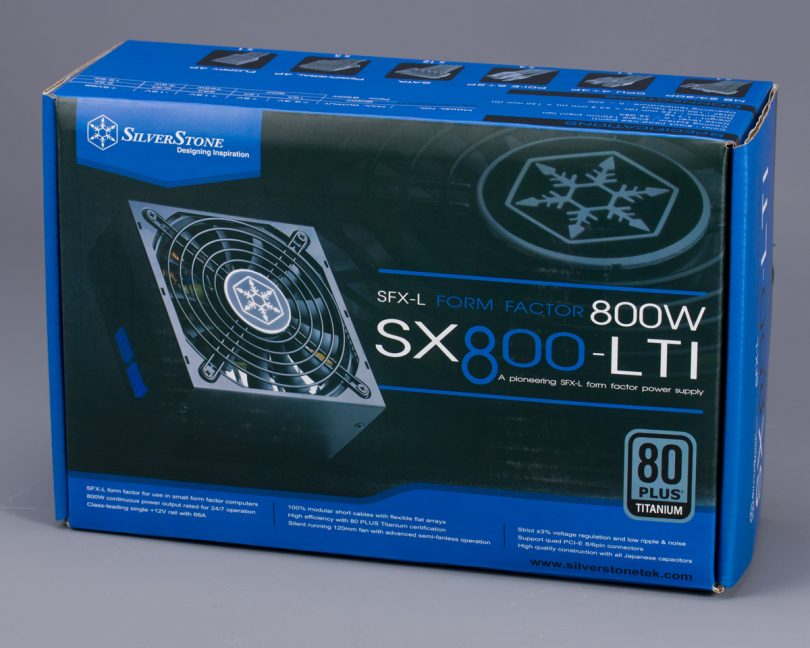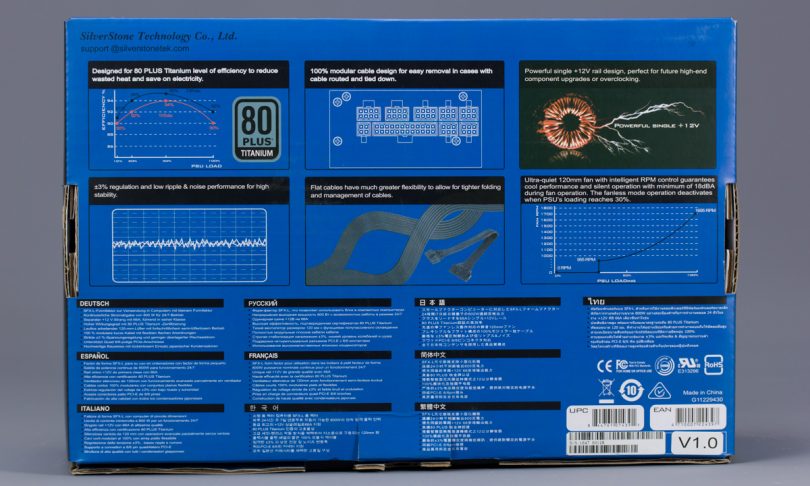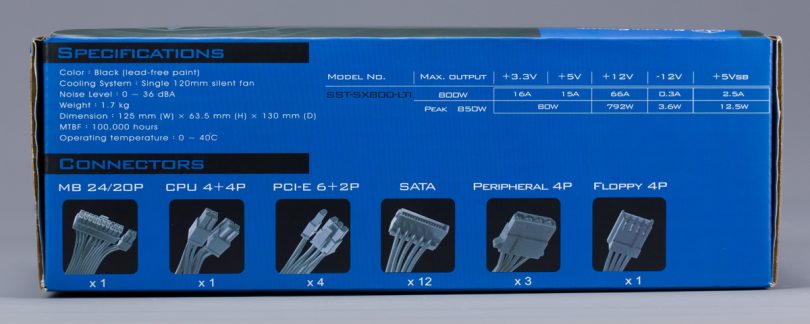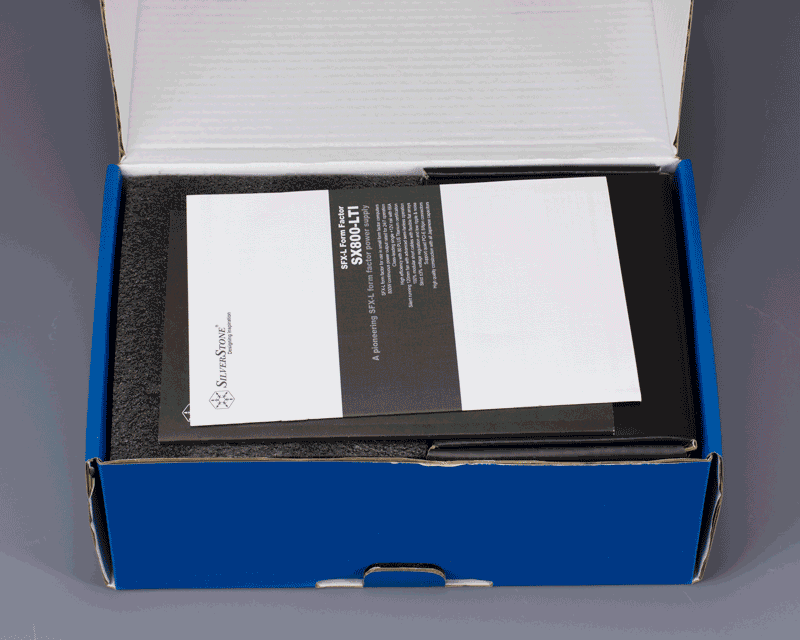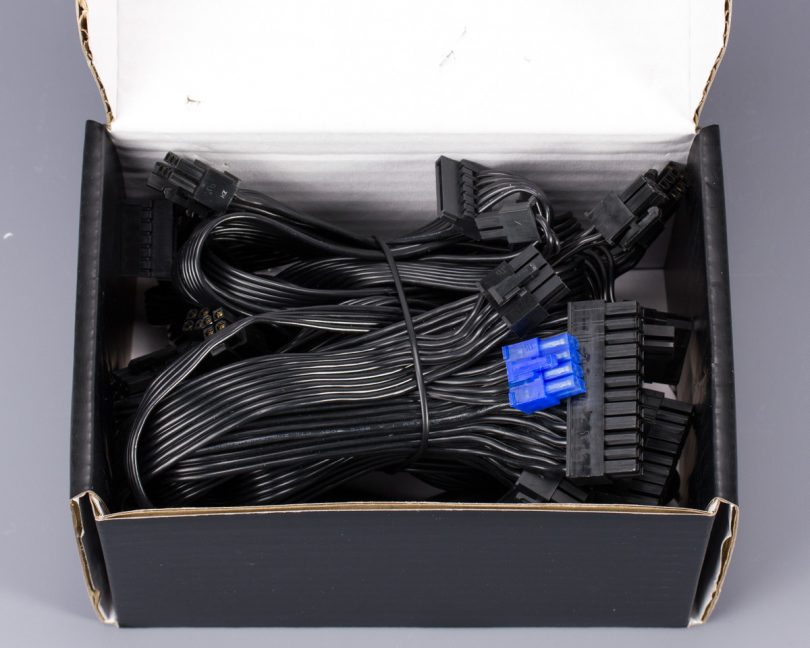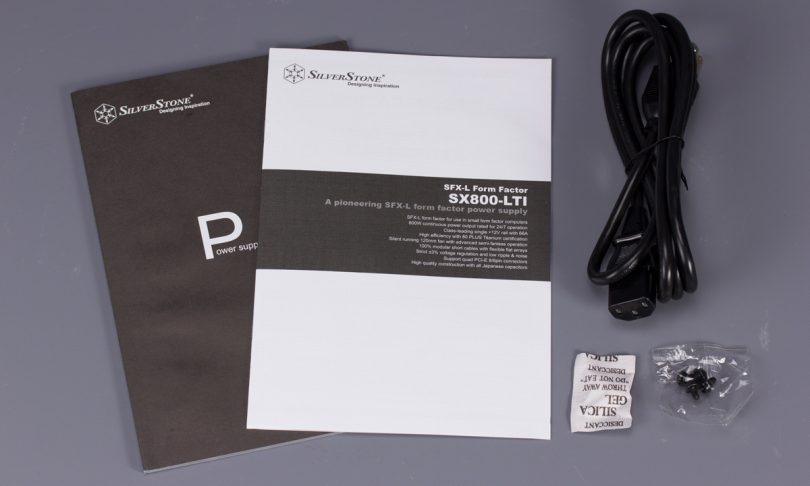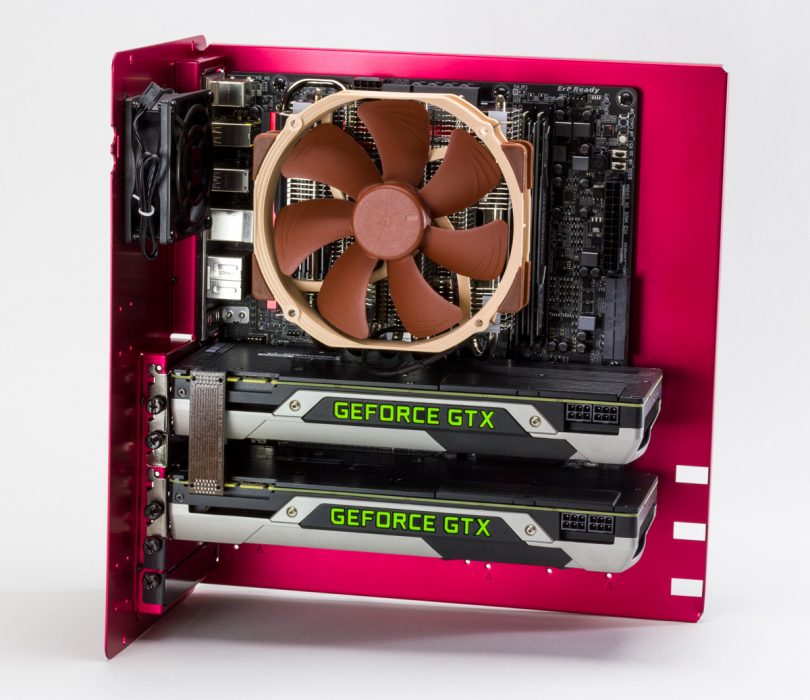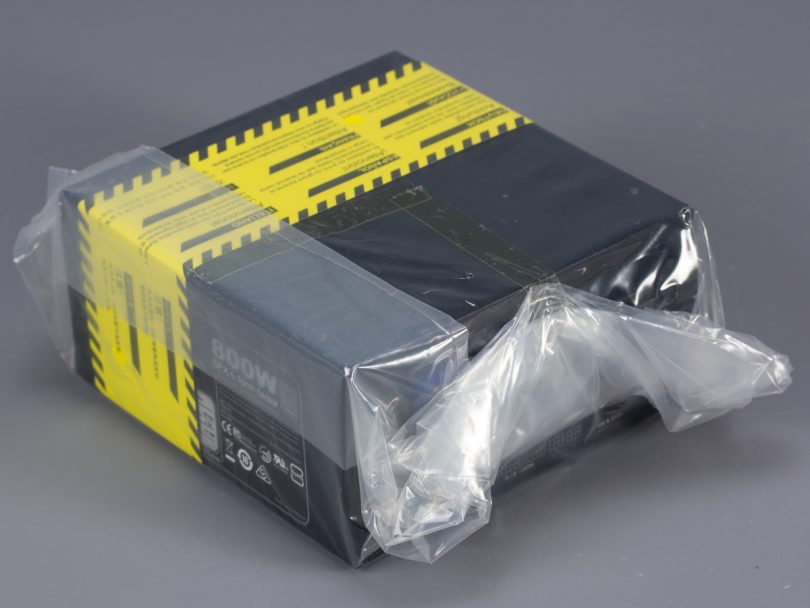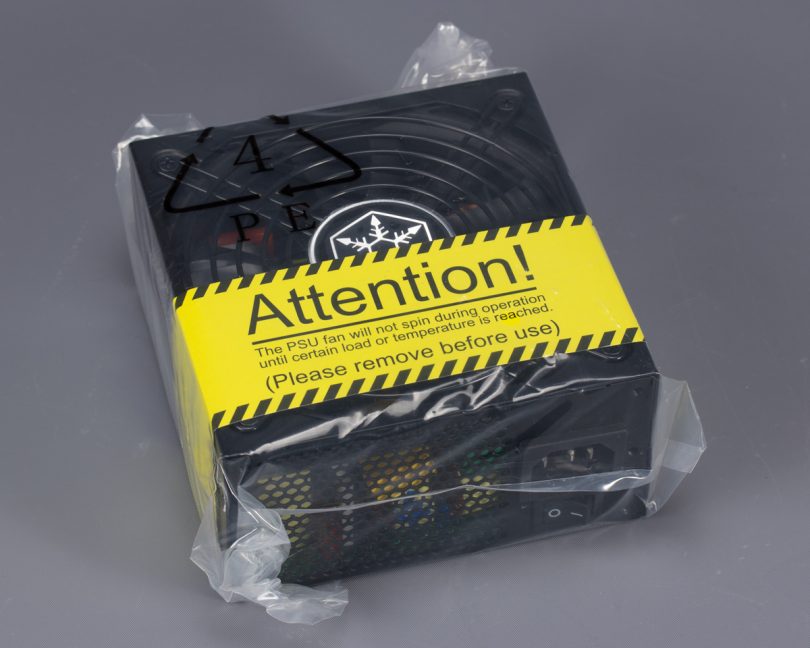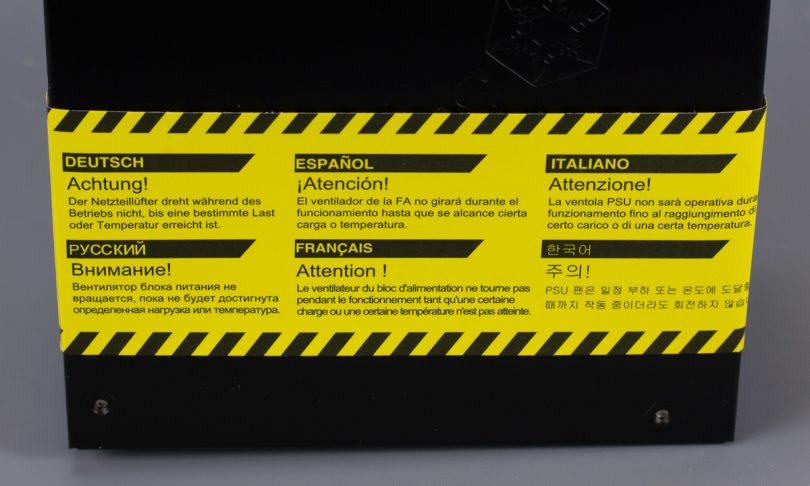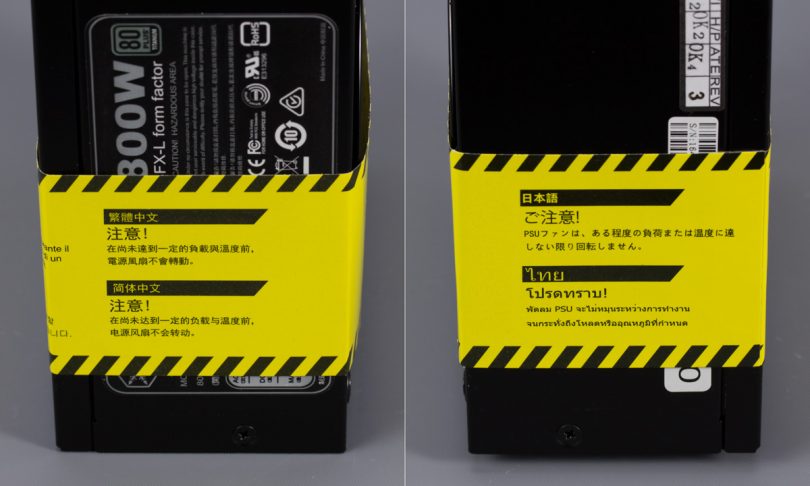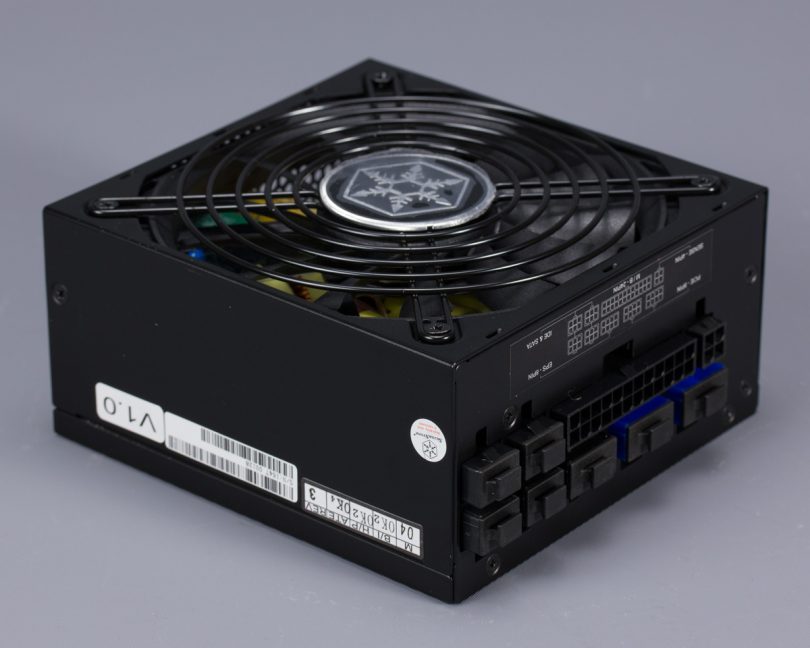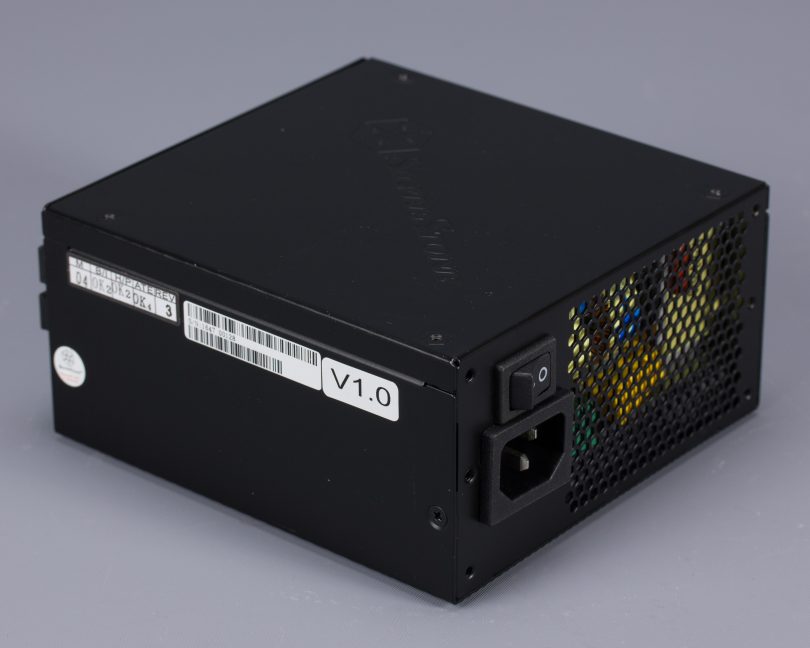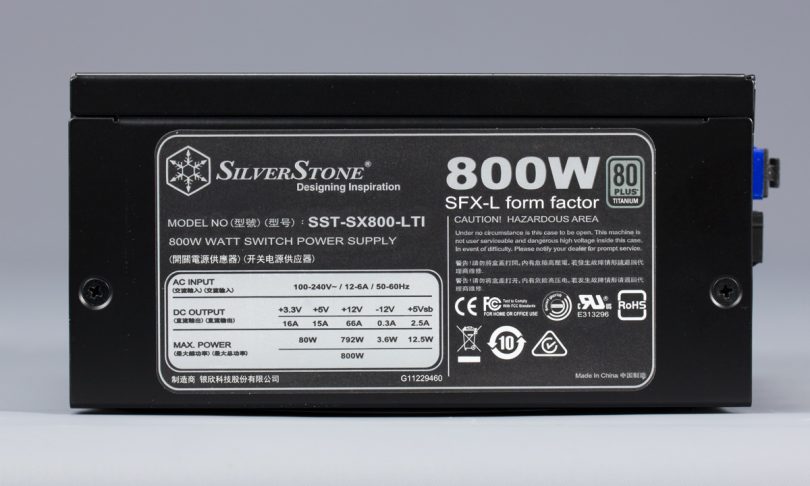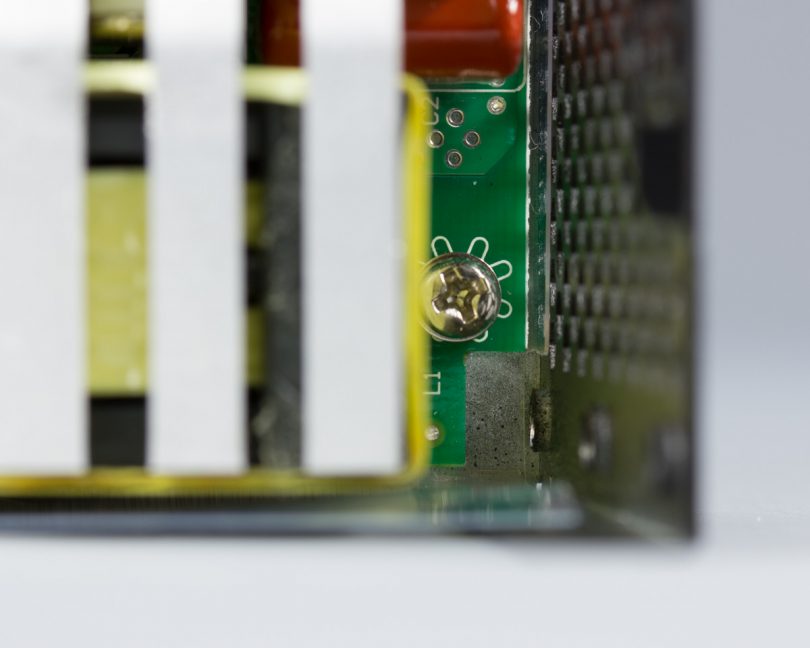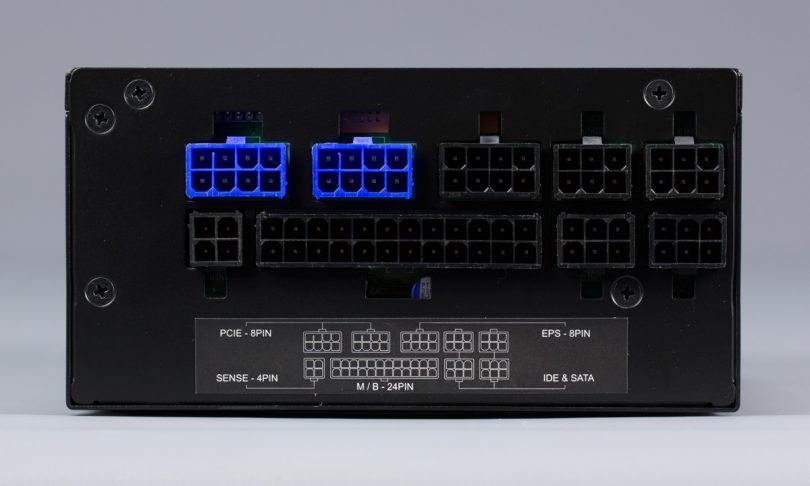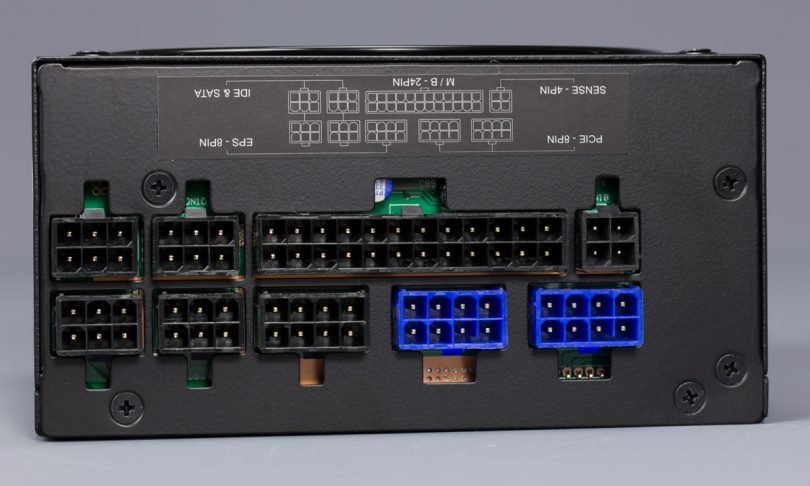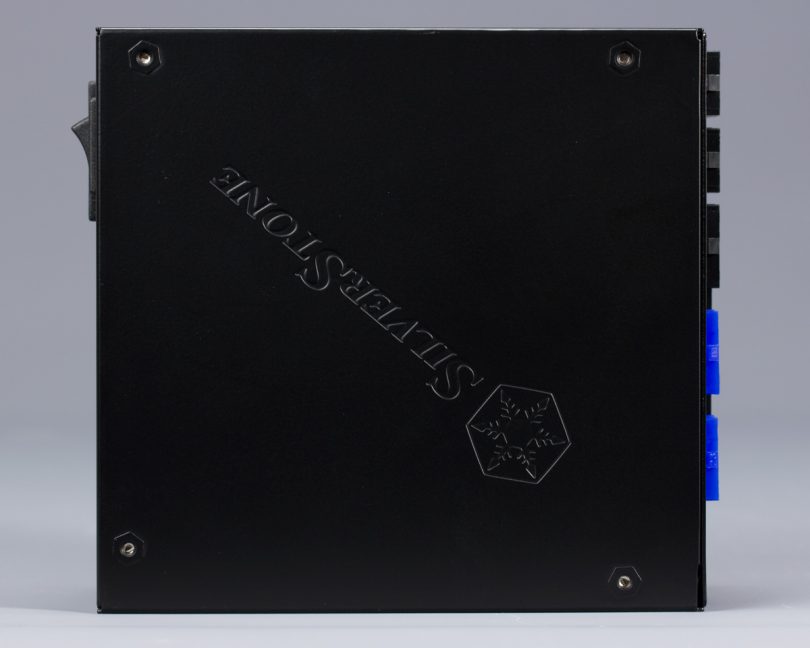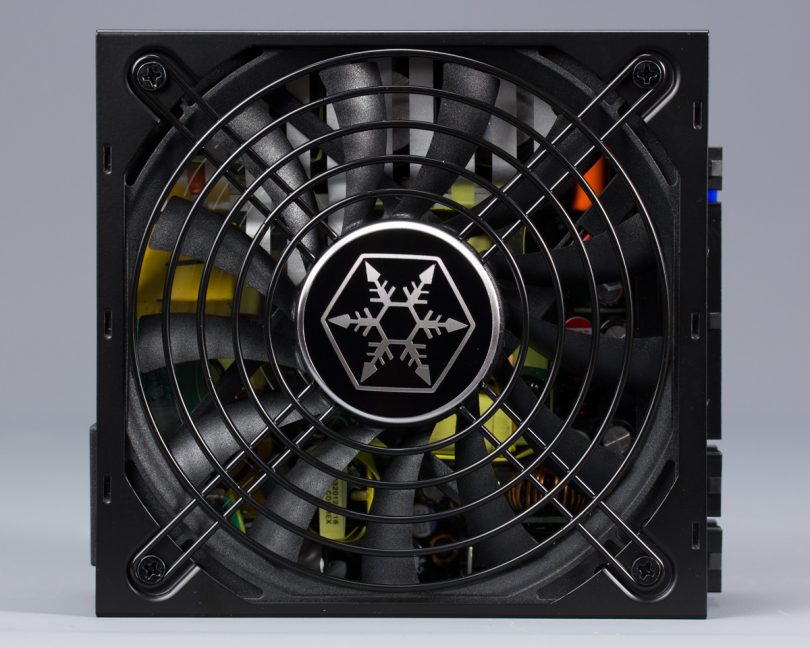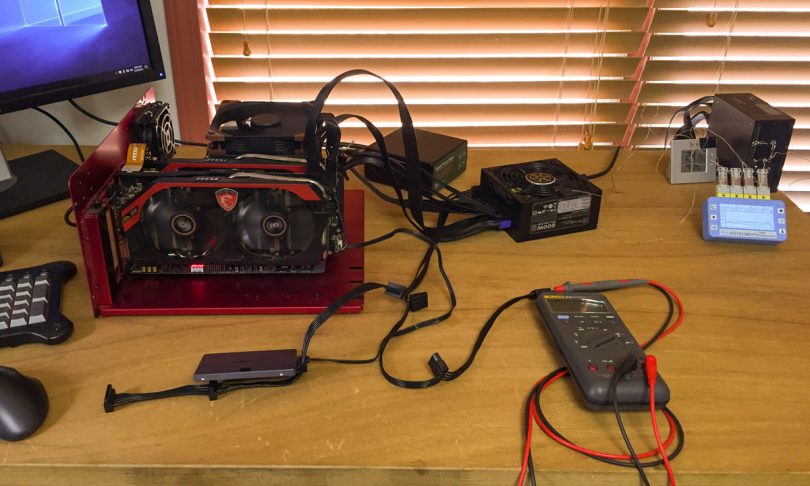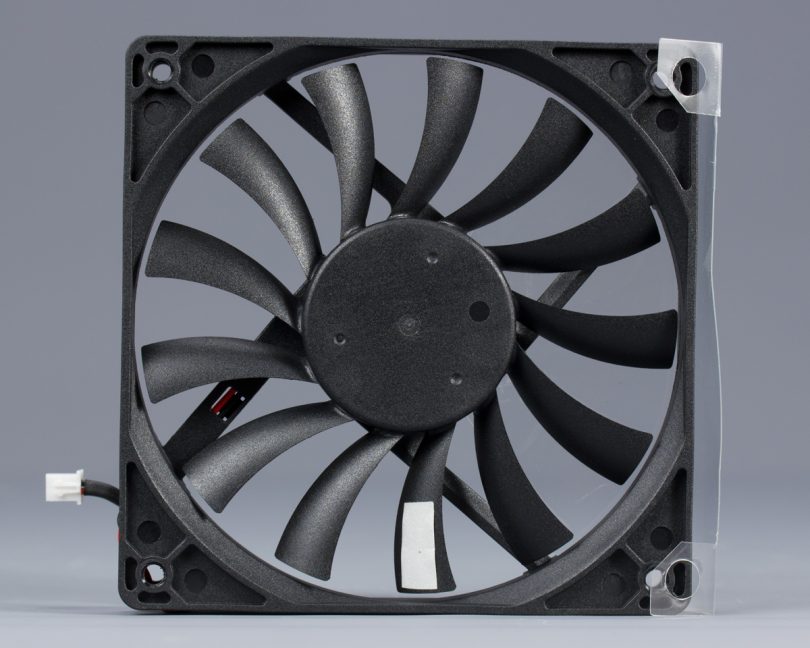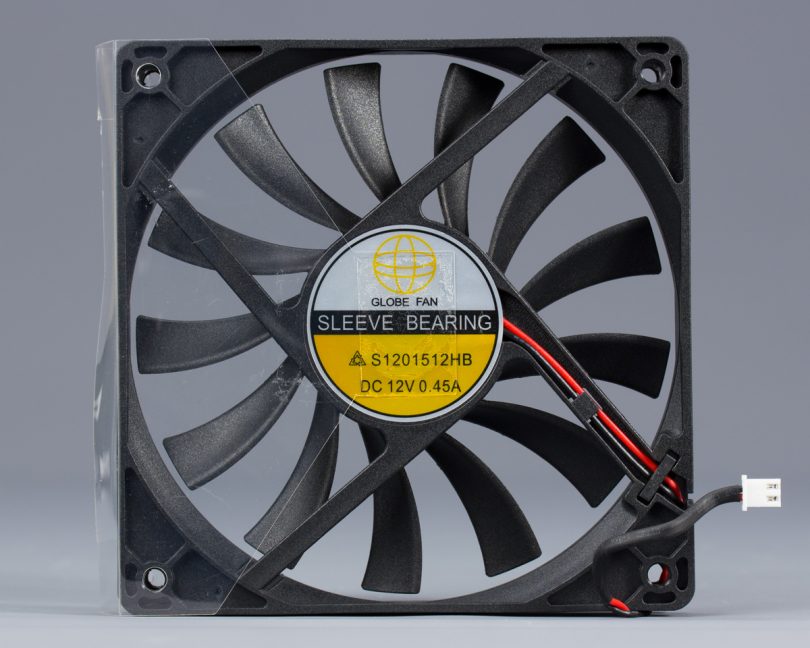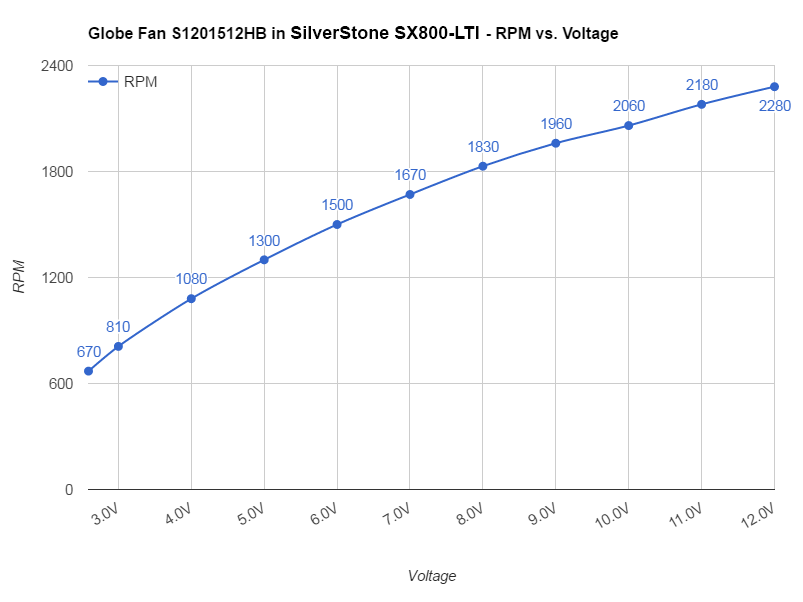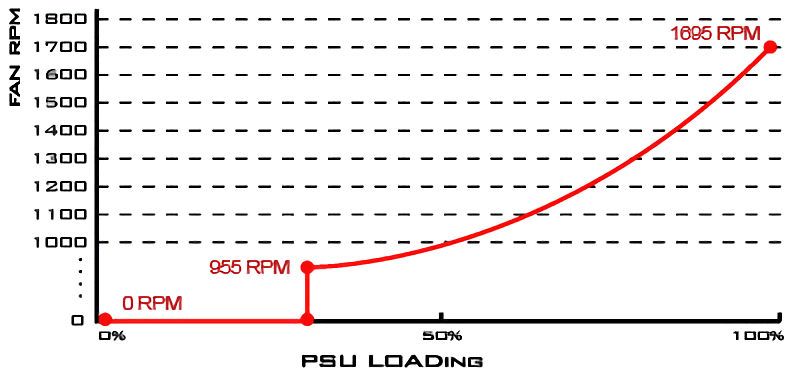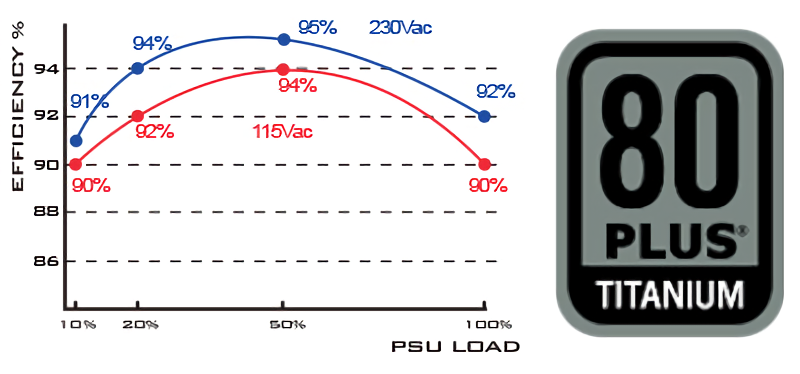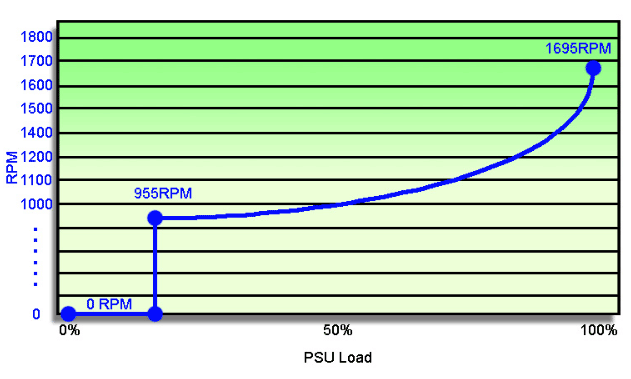It hasn’t even been a full year since the SX700-LPT came out, and yet Silverstone has already one-upped themselves on both wattage and efficiency with their just-released unit, the SX800-LTI. For those not familiar with Silverstone’s current SFF PSU model number scheme, that amalgam of numbers and letters translates to a 800W, SFX-L form factor, Titanium-rated efficiency, fully-modular power supply. Yes, seriously.
But before we dive into our review, the backstory for this unit is quite interesting in and of itself, as it was less than a week after my SX700-LPT review (a 700W, Platinum-rated unit) went up – when I was wrapping up the review for the Lian Li PE-750 (a 750W, Platinum-rated unit) – that some research I was doing for the former product turned up a reference for a “SX800-LTI” in the UL manufacturer directory. To see such a unit right after the hotly anticipated (but much delayed) 700W was quite a surprise, to say the least, and at first I shrugged it off as some sort of error. But I eventually decided to shoot off an email to Silverstone just to see what they said about the entry, not really expecting an answer right away since Computex was about to start.
It ended up being a very good thing that I thought to reach out to them, as they replied pretty quickly and confirmed that the unit was very real! And yet, this was all the way back in May, with Silverstone announcing availability and pricing only two weeks ago. Needless to say, the excitement for the impending release of this unit has run quite high among many SFF enthusiasts for the duration of this 6+ month wait, on our forums and beyond.
That wait, however, is now over, as it was just a few days ago I got my grubby hands on a sample. So, without further ado, on to the review!
Table of Contents
A disclaimer first before we get started: SFF Network does not currently possess the expertise or equipment to fully test the electrical performance of PC power supplies, and as such, this article should not serve as the sole data point in determining whether to purchase this product. We’ll be able to contextualize the utility and experience of using this unit with others in the market place, but we’d suggest having our own review supplement those by others who have the hardware and capability to do more thorough analysis of electrical performance, especially at higher wattages.
The Box
The box for the SX800-LTI is accented with a sharp looking shade of blue. The marketing blurbs on the front tout the 800W output (with 66A on the 12V rail), fully modular cables, Titanium-level efficiency, 120mm fan with semi-fanless functionality, ±3% voltage regulation, 4x 8/6-pin PCIe connectors, and the usage of all-Japanese capacitors.
Coming around to the back, it’s mostly the same information, but with pretty pictures and graphs to illustrate. One additional bit of info of note, though, is the fan curve chart: according to the text and graph, the fan spins up once the load reaches 30% at 955RPM (18dBA), and eventually ramps up to a maximum of 1695RPM at 100% load.
After my experience with the not not-really semi-fanless behavior on the SilverStone SX600-G and Lian Li PE-550, I was anxious to test this claim out. And as we’ll, see the figure on the packing is not quite correct.
On the top face of the box is a brief list of specifications, a load table, and a connector list. As mentioned on the front of the box, this unit can do 66A (basically the full rated wattage) on the 12V alone.
Opening up the box, we find that there’s not a bit of wasted space (which, as a SFF publication, we can’t help but to appreciate). A box containing the cables takes up the right half, the PSU is safely ensconced in closed-cell foam on the left, and the manuals lay on top of both.
Inside the aforementioned cable box are modular cables and a region-appropriate power cord. While a box is a big improvement over the SX700-LPT, which came with (literally) nothing to store the extra cables in, I would have liked to see a nice pouch as is often included with higher-end ATX power supplies, especially when considering the price of this unit.
Accessories
The set of accessories that comes with the SX800-LTI is surprisingly sparse; all told we find that there is the model-specific manual, the general SilverStone PSU manual, a power cord, 4x mounting screws, and a silica packet.
There’s no ATX adapter bracket included, but I have mixed feelings on that, which I’ll take the opportunity now to explain. On the one hand, it’s a non-trivial cost to include a bracket, and thus providing one would increase the cost of the unit unnecessarily for those using this unit in a natively SFX-L case. On the other hand, this is an expensive unit already, and it has the wattage to justify using it in an ATX system to save space (such as if/when an ATX PSU would jam up against a drive cage or interfere with other components) – so I’m sure quite a few of the buyers of this unit will actually have need for the adapter, only to be left with the need to spend a little more.
In reality there’s no perfect answer to whether or not customers are best served by inclusion or not for all, but I personally lean towards not including it since I’d like to see more cases that use SFX/SFX-L by default. Providing the bracket just gives antiquated case designs a crutch to stick around for that much longer. And for those who do need a bracket, SilverStone makes a nice offset design for just $9, so it’s not a huge outlay or anything.
Cables
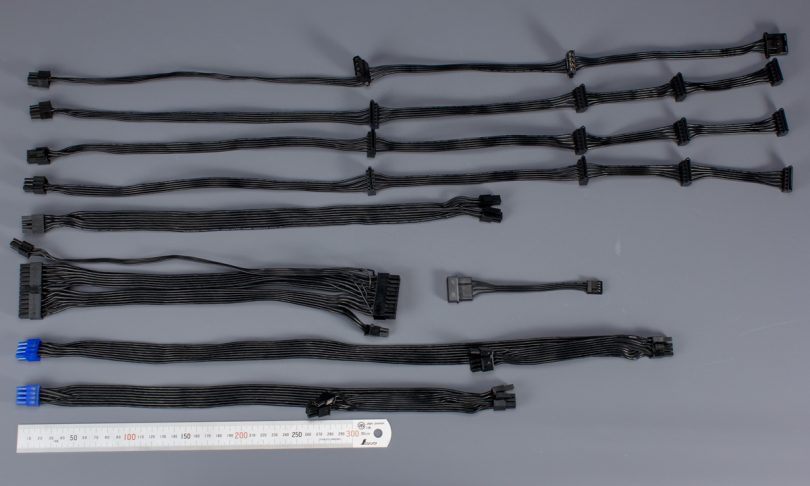
Cable lengths are as follows from top to bottom:
- 3x 4-pin Molex (300mm / 200mm / 200mm)
- 4x SATA (300mm / 200mm / 100mm / 100mm)
- 4x SATA (300mm / 200mm / 100mm / 100mm)
- 4x SATA (300mm / 200mm / 100mm / 100mm)
- 4+4-pin CPU (400mm)
- 24-pin (20+4) motherboard and 4-pin sense (300mm)
- 1x 4-pin Molex to Floppy adapter (100mm)
- 2x 6+2-pin PCIe (550mm / 150mm)
- 2x 6+2-pin PCIe (400mm / 150mm)
(The first number is from the PSU-side to the first connector, and the second number is from the first connector to the second, and so forth.)
Like the Lian Li PE-750, for some reason there are twelve (!) SATA connectors included. I thought it was a bit excessive when I reviewed the Lian Li, and I still think it’s a bit much for this unit as well. Full-tower cases that can take that many drives are pretty rare, let alone SFF cases that also require SFX/SFX-L form-factor power supplies.
Thankfully, unlike the PE-750 and like the SX700-LPT, SilverStone has the floppy power connector broken off into an adapter, instead of hardwiring it to the Molex strand. The floppy 4-pin power header is not commonly used in normal SFF builds, but it’s still nice to have for the occasional fan controller or the like. This seems like the best approach to take.
Also like the SX700-LPT, one of the PCIe strands is longer than the other; this is for mATX or ATX builds where the second video card would be further away from the power supply. A 150mm difference is likely overkill for microATX motherboards where a card in the top and bottom slots is only a difference of 60mm, but it could maybe come in handy for a ATX board that has greater spacing between the cards.
Since this is the same base platform that the PE-750 uses, the SX800-LTI also features the same 4-pin connector split off from the 24-pin for voltage sensing. This connector is not strictly required though and the unit will operate without it, so existing 24-pin cables made for other Silverstone modular units (like the SilverStone PP05-E kit or custom CableMod cables) will work, albeit with slightly worse voltage regulation as a result.
(Speaking of existing cables, the pinout is otherwise the standard Silverstone modular pinout. Lian Li used the same pinout for the PE-750, so the diagram for it here can be referred to for those interested in the arrangement of the extra 4-pin sense connector.)
Overall, I’m satisfied with the selection of connectors and cable lengths.
The Power Supply
After freeing it from the packaging foam, we see that the power supply comes in a slightly oversized (ATX-sized?) bag.
I don’t normally pay much attention to these warning labels but after seeing Lian Li not include such a label with both the PE-550 and PE-750, I decided to take a closer look this time around for kicks.
For first-time builders who aren’t familiar with them, they are warnings that the fan not spinning is intended behavior at low loads/low temperatures (due to the semi-passive functionality). This is to prevent users from returning the unit thinking it’s defective, when they turn the PC on and see the fan doing nothing. The front of the label has the warning in English.
With a clear view of the back, there is the same warning (at least I assume so) repeated in German, Spanish, Italian, Russian, French, and Korean…
…And on the sides, we have traditional Chinese, simplified Chinese, Japanese, and Thai.
So Silverstone should be able to avoid erroneous returns about the fan in much (most?) of the world with this one label. Though I guess they wanted to be doubly-sure, because when the PSU powers on the fan actually spins up to full speed for a second, making it very obvious that the fan is indeed working.
Anyways, with that little detour around the world out of the way, let’s take a look at the SX800-LTI itself!
Externally, it looks very similar to the SX700-LPT. The fan is a different model, though, and the connectors are arranged differently. They also stick out slightly further from the housing (4.8mm here, vs 2.1mm on the 700W).
Like the 700W, plastic covers for the unused modular connectors are included, presumably for dust and safety.
(BTW, the unit itself weighs 1.29kg.)
The typical label is on the side, with the expected load table and Engrish.
Turning the unit, we find warranty-void, QA check, serial number, and revision stickers on this side.
Finally, at the rear is the exhaust vent, power switch, and AC inlet. I must say that I really wish the AC inlet location and orientation was standardized, because it varies quite a bit between models, and cases with the SFX/SFX-L PSU internally mounted can run into the problem where an angled power cord (used to route power from the PSU to the rear of the case) interferes with the chassis with certain combinations of inlet position and orientation.
In fact, SilverStone has a compatibility chart on their website, and annoyingly quite a few of their own cases have this problem with the SX800-LTI:
SilverStone SFX case & adapter compatibility list for SX800-LTI
| Model | Compatibility |
| RVZ01 / FTZ01 / ML07 | No |
| RVZ02 / ML08 | Yes |
| SG05 / SG05-450 / SG05-LITE | No |
| SG06 / SG06-450 / SG06-LITE | No |
| FT03-MINI | No |
| ML05 / ML06 / ML06-E / ML09 | No |
| DS380 | No |
| CS01 / CS01-HS | No |
| CS280 | No |
| PP08 | Yes |
Tony Ou, the marketing manager at SilverStone, has said on HardForum that they will be updating several of their cases next year to address this issue. That’s good to hear, but then again it doesn’t help those who already have one of those cases, and it consequently feels like an oversight on SilverStone’s part – especially because it looks like there’s room for the inlet to have been flipped 90° counter-clockwise to match the SX700-LPT and SX500-LG. The power switch may have to be omitted to do so, but I feel that’s a worthwhile tradeoff for consistency, especially since these SFX and SFX-L units are often used in cases where the PSU is mounted internally (thus making that switch inaccessible anyway).
For the mounting screws, the corners of the PCB are inset slightly, but not by that much, so take care if using different screws than what the PSU came with.
While it’s pretty self-explanatory, I like that there’s a diagram for the modular connectors just to be safe.
One odd thing I noticed (and the PE-750 has the same issue) is that the cutouts in the housing – to make room for the clips on the modular connectors – are unnecessarily large for the 24-pin and PCIe connectors. To me, this partly defeats the purpose of the dust covers, since a not insignificant part of the modular connector PCB is exposed to errant screwdrivers or the like. It’s not a big deal, but it just stands out since there’s really no benefit I can see to having the openings made so large.
Lian Li went with a visually distinctive concentric square design punched from the metal on their 750W, but I’m glad to see that Silverstone has carried over the wire grill from their other SFX-L units since it’s less restrictive to air.
Testing
As mentioned at the beginning of the review, we currently lack the expertise and equipment to properly evaluate the electrical performance of power supplies to a complete extent, so the following data is more to demonstrate that the Silverstone SX800-LTI is capable of powering the test system with no issues.
A quick note:
The hardware has changed again from the previous PSU reviews. I have swapped the dual GTX 980’s with R9 280X’s because, funnily enough, the 980’s were too efficient and were no longer adequate for testing these ever-higher wattage SFF power supplies. That’s perhaps the best possible problem to have, though, right?
Test hardware:
| CPU | Intel Core i7-5930K |
| Motherboard | Asus X99-M WS |
| Cooling | Noctua NH-C14S with black NF-A14 PWM |
| PSU | SilverStone SX800-LTI |
| RAM | Crucial Ballistix Sport 16GB (2x8GB) DDR4 2400 |
| Video Card | 2x MSI Radeon R9 280X Gaming |
| Storage | Samsung 840 EVO 500GB |
| Case | Lian Li PC-6X tray |
| OS | Windows 10 64-bit |
Test equipment:
- Brand Electronics 4-1850 power meter, used to measure the AC draw of the system.
- Reed AT-6 non-contact tachometer, used to measure the fan RPM.
- Pax Instruments T400 temperature datalogger with Omega thermocouples, used to measure ambient, intake, and exhaust temps.
- Fluke 83 III multimeter to measure voltage.
Methodology:
Each test is run for 10 minutes, and then readings are taken before moving on to the next test. Both video cards were installed for all tests, but on the fourth test CrossFire was disabled and FurMark was run on a single GPU. For the fifth and last test, CrossFire was enabled and FurMark was run on both cards.
Test Results:
| Wattage (AC) | Ambient Temp | Intake Temp | Intake Delta | Exhaust Temp | Exhaust Delta | Fan RPM | 12V | Test |
| 73W | 26.0°C | 33.1°C | 7.1°C | 26.0°C | 0°C | 0 RPM | 12.07V | Idle |
| 133W | 26.3°C | 35.6°C | 9.3°C | 31.2°C | 4.9°C | 0* RPM | 12.08V | 2 threads of Prime95 Blend |
| 185W | 27.5°C | 28.7°C | 1.2°C | 36.2°C | 8.7°C | 940 RPM | 12.08V | 10 threads Prime95 Blend |
| 455W | 24.1° | 27.0°C | 2.9°C | 41.3°C | 17.2°C | 940 RPM | 12.09V | 10 threads Prime95 Blend, FurMark 1x 280X 720p no AA |
| 600W | 24.3° | 24.8°C | 0.5°C | 47.5°C | 23.2°C | 950 RPM | 12.09V | 10 threads Prime95 Blend, FurMark 2x 280X 1080p 4x AA |
*Fan started up for a few seconds about 8 minutes into the test.
The SilverStone SX800-LTI powered my test setup with no issues.
Fan
Cooling for the SX800-LTI is provided by a 120 x 15mm 13-bladed fan. Note that the silver rectangle on the bottom blade is a piece of reflector tape for the non-contact tachometer.
The model of the fan is a Globe Fan S1201512HB. This is the same model as the fan we encountered in the Lian Li PE-550… of which there is still no information online about, unfortunately. All we have to work with are the markings on the fan itself, which indicate this uses a sleeve bearing and draws up to 0.42A at 12V.
The measured fan curve on this S1201512HB is slightly different than the one in the PE-550, but it’s within the margin of error for both my measurement equipment and typical sample variance. Starting/stopping voltage is also about the same, 2.60V, and the same fast but quiet “ticking” noise is present from 2.55-2.59V (though as we’ll see later, it’s not a problem in this unit due to the fan controller’s behavior).
The triangular piece of plastic visible in the previous pictures is attached to the fan hub with adhesive, with the fan screws holding it in place at the corners. The shield is positioned towards the rear of the PSU, and is used to force airflow around and through the internal components, instead of just escaping straight out the rear exhaust vent. These type of shields are occasionally used in ATX units, but this is the first one I’ve encountered on a SFX or SFX-L PSU.
Unlike the Lian Li 750W, the SilverStone does not have rubber grommets to dampen vibration between the fan and the housing.
Fan Controller
I noticed in the performance testing that the fan turned on immediately at the start of Test 3 (185W AC draw) so I went back and conducted a few extra tests with Prime95 to try to determine the trip point, because the marketing claims that the fan turns on at 30% load (240W).
What I found is that upon starting Prime95 on Blend mode with 3 threads, the system drew 155W from the wall and the fan spun up immediately. Then I switched straight from 3 threads to 2 threads without stopping the stress test, which dropped AC draw to 133W, and the fan immediately shut off. Then, I cycled up to 3 threads and back down to 2 threads again for good measure, with the same results.
This indicates the controller is basing the fan startup on load, because there wasn’t nearly enough time for the thermistor to heat up or cool down a meaningful amount.
Note: For the following calculations, keep in mind that the Brand 4-1850 meter used for measuring power draw isn’t perfectly accurate (±2% accuracy), but to keep things simple I’ll just use the measured readout.
Based on this testing, that means the trip point on my unit is somewhere between 133W and 155W, as measured at the wall, let’s say 145W. An 80 Plus Titanium-rated PSU is 90% efficient at 10% load and 92% efficient at 20% load at 115VAC. The wattage we’re interested in somewhere between those two loads, so let’s say it’s 91% efficient. Doing the math gives ~132W DC draw, or what the PSU is actually providing to the system (the difference is lost as waste heat).
So instead of 30%, my unit’s fan spins up at more like 17% load. That’s quite a difference so I emailed SilverStone to check what they thought of this discrepancy.
As it turns out, the marketing team reused the fan curve graphic from the SX700-LPT and accidentally left the load level the same. Above is the correct graph that I received from SilverStone.
The correct PSU load level for fan start is 20% (160W) and this is much more in-line with my testing. The product page on SilverStone’s website has already been updated with the correct figure and future production runs will have the retail box updated as well.
Starting point aside, once the fan does spin up, it does so at around 940RPM, so the marketing graph is correct in that regard. After the fan turns on, my testing shows that the fan controller is then primarily temperature-based, because from Test 2 at 133W AC to Test 5 at 600W AC, the fan RPM only crept up 10RPM with my open-air setup. With a blow dryer I then verified that the controller will increase the fan speed as intake temperatures increases, up to the max RPM of the fan. Though fear not, for the intake temp was registering something like 80°C, so under normal circumstances the fan should never reach those kinds of speeds.
Since the semi-fanless function is primarily load-based, I also double-checked if this model exhibits the same problem as the original SX700-LPT units. The 700W also turns the fan on once a certain load is reached, but if the system ran just below that threshold for sustained periods of time (like mainstream gaming on mid-range hardware) in a case where the PSU gets warmed up by the GPU exhaust, the OTP (Over Temperature Protection) could trigger before the fan ever turned on. Once Silverstone became aware of this issue they made a running production change to lower the fan’s starting wattage to address the problem, but to my knowledge the fan’s starting point is still purely load-based.
To check the SX800-LTI for this issue, I used the blow dryer to warm up the intake while the test system idled, and the fan did kick on before too long. So the 800W does not suffer from the same low load OTP issue as the 700W. Not only that, but the fan turned back off once the blow dryer was shut off and the unit cooled down a bit (exhaust temp was at around 50°C when the fan stopped).
The actual fan controller output voltage is fairly straightforward. At power-on, the voltage spikes to 12V and the fan spins up accordingly, then gradually ramps down over several seconds to 0V. Once the load or temp threshold is reached, the voltage immediately jumps to 3.4V, avoiding the transition range where the fan would make that ticking noise. If the temperature dictates, the voltage will rise, thus increasing the fan speed. Once the load/temperature drops below the fan start threshold, the voltage immediately drops to 0V.
Protections
I repeated Test 5 but with a blow dryer pointed at the intake, and OTP kicked in and shut the unit down like it’s supposed to. Exhaust temp was reading about 85°C at the time of shutdown.
The unit would not immediately power back on, even after flipping the power switch and letting the power drain. After cooling off for a few minutes, though, it turned right back on without issue.
According to SilverStone’s specs, there is also Over Current, Over Power, Over Voltage, Short Circuit, and Under Voltage protection.
Noise
My thoughts on noise are basically the same as I said in the Lian Li PE-750 review, since the fan controller behaves the same between them. With adequate cooling, the SX800-LTI is great at mid to high loads since the fan curve is actually more of a line than a curve.
The problem is low loads, since the fan turns on at a fairly low load level considering the wattage and efficiency and does so at 940RPM. At that speed it’s not loud by any means, but it’s definitely not silent, either. If it would spin up at a higher load then the relatively high starting speed would be easily excusable since that would cover any mid-range setup at heavy load, and a high-end rig at low to medium load.
The fan’s noise signature is fairly smooth with no annoying buzzing or whining. There is a slight rasping noise like the PE-550, but on this sample it’s more subdued and I only really noticed it for a second or two when the fan spins up or slows to a stop.
I did not notice any buzzing or coil whine from the power supply itself, but one of the 280X’s has very bad coil whine so it could easily have been masking any noise PSU was making. For what it’s worth, the PE-750 is based on the same platform and I did not encounter any coil whine when testing that unit.
Internals
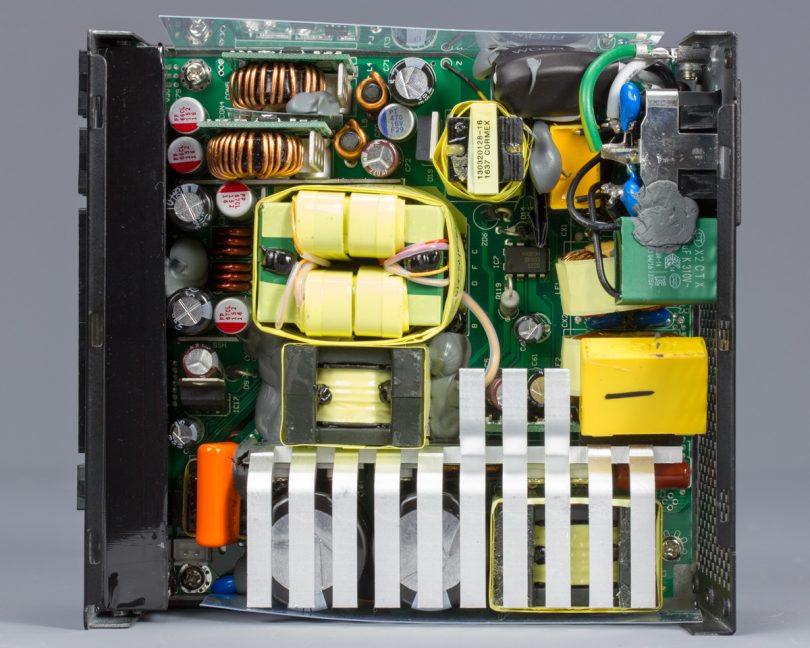
I’m not qualified to speak to the internal build quality but on first glance it’s actually not nearly as cramped inside as you would think for a 800W Titanium-rated unit that’s 1.0 liters in volume.
All the electrolytic capacitors are either Nippon Chemi-con, Rubycon, or Unicon, all of which are Japanese brands. It’s hard to tell since many of the caps are butted up against other components and the temperature rating is usually on the wrong side, but all the electrolytics I can see are either 105°C or 125°C rated.
As previously mentioned, this is the same platform as the Lian Li PE-750, the OEM for which is Enhance Electronics.
Conclusion
Even just two years ago, an 800W, fully-modular, Titanium-rated SFF power supply with a 120mm fan was just a pipe dream – yet now it exists along with 750W and 700W Platinum-rated alternatives! So now that it’s here, the question becomes “who really needs such a beast?”
After all, anyone who’s crunched the numbers on how much power a typical gaming system really needs knows that 800W is complete overkill for the average ATX build. Mini-ITX is limited to a single video card on top of that, and current-gen video cards are more power efficient than ever before. This begs the somewhat obvious question as to whether or not there is literally anyone who really, actually needs 800W for their SFF build.
Maybe, maybe not. But I think only looking at maximum power consumption misses the point, because there are many other reasons to consider this unit:
- First is bragging rights, naturally: SFF has come a long way in recent years but, the mindset that a small computer can’t possibly be very powerful is still all too common. So seeing the look on people’s faces at a LAN party when you tell them your tiny PC has more wattage (and higher efficiency to boot!) than their full tower monster is priceless.
- A more practical reason is that many people still grossly overestimate how much power their system draws, so the availability of such a high-wattage SFX-L unit can get them in the door when they would have otherwise dismissed SFF due to the lack of beefy enough PSUs (though, hopefully they will eventually learn about the actual power consumption of modern hardware).
- It also opens the possibility of more space-efficient case designs outside of Mini-ITX. Lian Li has already started to do this with their PC-O10 chassis, which takes advantage of the shorter height to make a dual-chamber ATX case that’s still relatively slim. And while it’s hard to see the use case from a power draw perspective on ITX, a high-end and heavily overclocked microATX or ATX system makes 800W much more justifiable and maybe even necessary.
- It’s a bit negated by the fan controller behavior at the low end for this particular unit, but some users get overkill power supplies to ensure their system spends most/all of the time at the lower end of the PSU’s fan speed range.
And that’s ignoring what is probably the real reason this unit exists: as a halo product for Silverstone. 800W and Titanium-rated is fairly rare, even for ATX, but in a SFX-L form factor it’s nothing short of amazing! This halo effect also goes much further in the SFF PSU space, since it’s still fairly young, while the ATX power supply market is a very mature and saturated market filled with entrenched competition (Corsair alone has over 50 different ATX power supply models), making it very difficult to stand out above the crowd.
Realistically, Silverstone may not sell very many of these units, but I’m very glad it exists, and that they continue to push the form factor forward. They’ve done a great service to the SFF community in this regard, keeping in line with their reputation as the first to bring powerful SFX units to the market.
Power saving rant
…I will say, though, that saving on the power bill should absolutely NOT be on the list of reasons to buy the SX800-LTI. Yes, it’s Titanium-rated, so it will draw less power than less efficient power supplies – but unless your electricity is very expensive and you have constant high power draw (cryptocoin mining?), it doesn’t make financial sense. For example, in Hawaii the average residential electricity cost is $0.35/kWh. At a constant load of 400W (DC) that would work out to $1333/year for a Platinum unit (assuming ~50% load, 92% efficiency) and $1304 with a Titanium unit (also 50% load, 94% efficiency), for a difference of $29.
The SX700-LPT can be purchased for about $150 ($135 after rebate) while the SX800-LTI’s MSRP is $180. So in the above example, going with the SX800-LTI over the cheaper but less efficient unit would pay off within two years. That would make sense.
But a somewhat more realistic scenario would be the system on average idling at 65W DC for 16 hours a day, and gaming at 400W DC for 8 hours a day, at the USA average residential rate of $0.13/kWh. Assuming 90% efficiency at idle for both and 92% and 94% for gaming, then in this scenario we come up with a cost savings of only $2/year by going with the Titanium unit. Even if you’re lazy and don’t fill out the rebate, it would still take 15 years for it to pay off in savings on your electricity bill, and that’s before adjusting for inflation.
Obviously, that doesn’t make much fiscal sense. So if you’re considering buying the SX800-LTI, think of the power savings as icing on the cake, but not a deciding factor – unless you’re a cryptocoin miner in the Aloha state, or something.
Note: Please don’t take this to mean I’m saying better efficiency is worthless, because better efficiency in general is good for the world because it reduces electricity use. Higher efficiency also has the practical benefit of less waste heat being generated. Less waste heat means less cooling is required, and lower cooling requirements means lower noise, at least in theory. It’s just in regards to the power bill savings paying for itself that I’d caution skepticism.
Conclusion continued:
So raison d’etre and payback period aside, what about the competition? Well, the only two remotely comparable products to this unit are the Lian Li PE-750 and Silverstone’s own SX700-LPT, as have been mentioned previously. They’re both “only” Platinum-rated, and the wattage is a bit less, but they’re both significantly cheaper at $140 for the Lian Li and $150 ($135 w/ rebate) for the 700W Silverstone.
Still, that alone counts for a lot, and to me this is the biggest problem with the SX800-LTI: the Silverstone has a slightly longer warranty (3 years vs 2 years) compared to the Lian Li, on top of 50W more power delivery, but beyond this the differences are minimal. The Lian Li is based on the same platform, which means that they share most of the same strengths and weaknesses – and the PE-750 also comes with a cable pouch (a cheap one, but something rather than nothing) and an ATX bracket, all for $40 less.
Additionally, Silverstone’s 700W has the same 3-year warranty, and less wattage, but a different fan controller implementation that may actually be preferable from a noise aspect to the other two units depending on your priorities.
So why should you buy the SX800-LTI, then? Some may truly need 800W in this form factor for their system, in which case you don’t have a choice, and you’re probably already sold on the unit. But for everyone else, I think it’s mostly a function of desire over necessity – to say you have the “best” SFX/SFX-L unit available, to future-proof yourself from potential future upgrades, and so forth.
Indeed, if there’s one word I could use to describe the SX800-LTI, it would be “excessive” – an excessive price, to be sure, but in exchange for totally excessive performance, power density, and – let’s face it – mad bragging rights at your next LAN party.
[mks_separator style=”blank” height=”2″]
As mentioned, the SX800-LTI’s MSRP is $180 (€180 excluding VAT), and it should starting showing up as in stock at retailers throughout North America this week or next.
Thoughts? Discuss them in the forum here.
[mks_separator style=”blank” height=”2″]
Review sample provided by Silverstone.

